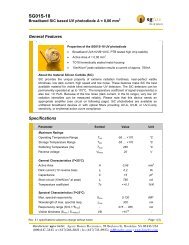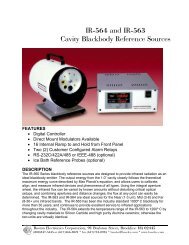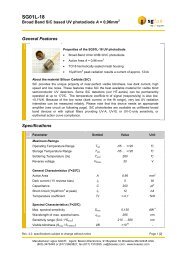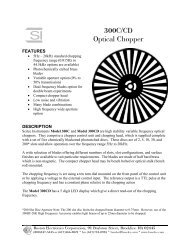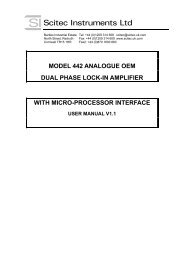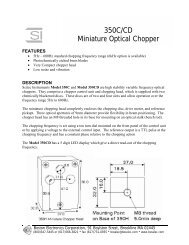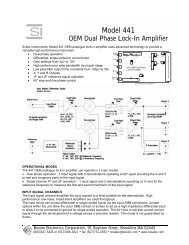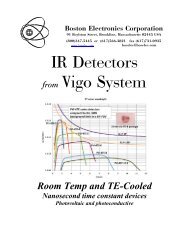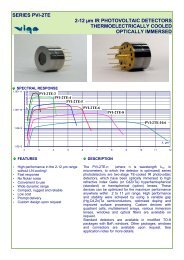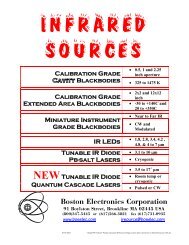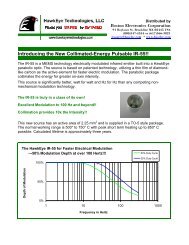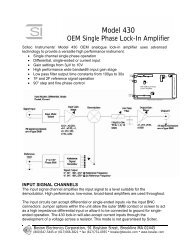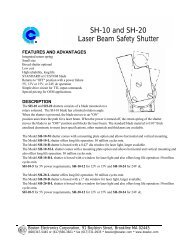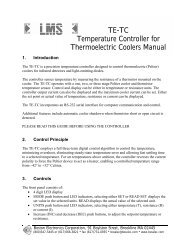TCSPC for FLIM and FRET in - Boston Electronics Corporation
TCSPC for FLIM and FRET in - Boston Electronics Corporation
TCSPC for FLIM and FRET in - Boston Electronics Corporation
You also want an ePaper? Increase the reach of your titles
YUMPU automatically turns print PDFs into web optimized ePapers that Google loves.
There<strong>for</strong>e, the fluorescence light need not be fed back through the scanner <strong>and</strong> through the p<strong>in</strong>hole.It can be diverted by a dichroic mirror directly beh<strong>in</strong>d the microscope objective. This setup is called‘non-descanned detection’ <strong>in</strong> contrast to the ‘descanned detection’ shown above.Two-photon excitation <strong>in</strong> conjunction with non-descanned detection can be used to image tissuelayers as deep as 500 µm. S<strong>in</strong>ce the scatter<strong>in</strong>g <strong>and</strong> the absorption at the wavelength of the twophotonexcitation are small the laser beam penetrates through relatively thick tissue. Even if there issome loss on the way through the tissue it can easily compensated by <strong>in</strong>creas<strong>in</strong>g the laser power.The <strong>in</strong>creased power does not cause much photodamage because the power density outside thefocus is small. However, as long as there are enough ballistic (non-scattered) excitation photons <strong>in</strong>the focus the fluorescence is excited. Of course, the fluorescence photons are heavily scattered ontheir way out of the tissue <strong>and</strong> there<strong>for</strong>e emerge from a relatively large area of the sample surfacewhich is out of the focus of the objective. However, <strong>for</strong> non-descanned detection there is no need tofocus the fluorescence light anywhere. There<strong>for</strong>e the fluorescence photons can be efficientlytransferred to the detector.It is sometimes believed that lifetime imag<strong>in</strong>g is somehow connected to two-photon excitation. Thisis, of course, not correct. Depend<strong>in</strong>g on the signal process<strong>in</strong>g technique used, lifetime imag<strong>in</strong>grequires a pulsed or modulated laser. Although a Ti:Sa laser is the ideal source lifetime imag<strong>in</strong>g ispossible with the frequency doubled Ti:Sa laser, with pulsed diode lasers, or with modulated CWlasers.Optical Near-Field MicroscopyThe optical near-field microscope (SNOM or NSOM) comb<strong>in</strong>es the pr<strong>in</strong>ciples of the atomic <strong>for</strong>cemicroscope <strong>and</strong> the laser scann<strong>in</strong>g microscope [24-28]. A sharp tip is scanned over the sample <strong>and</strong>kept <strong>in</strong> a distance comparable to the diameter of a s<strong>in</strong>gle molecule. The tip can be the end of atapered fibre through which the laser is fed to the sample (fig. 7, left). Or, the tip is illum<strong>in</strong>ated byfocus<strong>in</strong>g the laser through the microscope objective on it <strong>and</strong> the evanescent field at the tip is usedto probe the sample structure (fig. 7, right). In any case, the fluorescence photons are collectedthrough the microscope objective.leverFibreLaserleverscanSamplescanSampleDetectionMicroscopeObjectiveDetectionMicroscopeObjectiveLaserFig. 7: Optical near-field microscopeThe optical near-field microscope reaches a resolution of a few 10 nm, i.e. about 10 times less thanthe laser scann<strong>in</strong>g microscope. Imag<strong>in</strong>g cells with this technique is difficult <strong>and</strong> possibly restrictedto special cases [27,28]. The realm of the optical near-field microscope are certa<strong>in</strong>ly applicationswhere fluoresc<strong>in</strong>g molecules or nano-particles are fixed on a flat substrate.Generally, the SNOM pr<strong>in</strong>ciple can be comb<strong>in</strong>ed with flourescence lifetime imag<strong>in</strong>g <strong>in</strong> the sameway as the normal laser scann<strong>in</strong>g microscope. S<strong>in</strong>ce only a small number of photons can beobta<strong>in</strong>ed from the extremely small sample volume photon count<strong>in</strong>g techniquesare used to obta<strong>in</strong>lifetime <strong>in</strong><strong>for</strong>mation [78]. The problem to be expected is that the proximity of the tip changes the7



